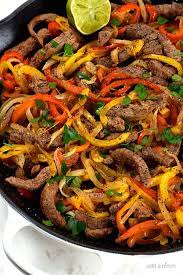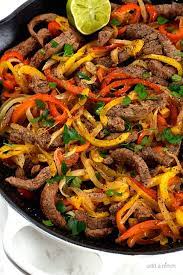Are you a fan of Mexican cuisine and want to explore new dishes? Look no further than Fajitas, a delicious and savory meal that has taken the world by storm. In this comprehensive Blog, we’ll cover everything you need to know about fajitas, from their origin and history to how to prepare them and the nutritional benefits of this beloved dish.
Origin and History of Fajitas
The origin of fajitas can be traced back to the 1930s in the ranch lands of West Texas, where cattle ranchers would give the less desirable cuts of meat, such as the skirt steak, to their Mexican vaqueros (cowboys). The vaqueros would marinate the meat in lime juice and other seasonings to tenderize it and then grill it over an open flame.
As the dish gained popularity, it migrated south to Mexico, where it was served with tortillas and various toppings like onions, peppers, and salsa. In the 1960s, a restaurant in Houston, Texas, called Ninfa’s, popularized the dish and dubbed it “fajitas,” meaning “little belts” in Spanish, due to the skirt steak’s shape.
Everything to Know About Fajitas
Fajitas are typically made with either chicken or beef, but can also be made with shrimp, pork, or even tofu for vegetarians. The meat is marinated in a mixture of lime juice, garlic, chili powder, and other seasonings to give it a tangy and spicy flavor. The marinated meat is then grilled over high heat and sliced into thin strips.
The toppings for fajitas usually include sautéed onions and bell peppers, which add a crunchy texture and a burst of flavor. Other common toppings include shredded cheese, sour cream, guacamole, and salsa.
How to Prepare Fajitas
To prepare fajitas, start by marinating your meat of choice in a mixture of lime juice, garlic, chili powder, cumin, salt, and pepper for at least 30 minutes. While the meat is marinating, sauté sliced onions and bell peppers in a skillet until they are tender.
Next, grill the marinated meat over high heat for about 3-4 minutes per side, or until it is cooked to your desired level of doneness. Once the meat is cooked, slice it into thin strips and toss it with the sautéed onions and peppers.
To serve, heat up some tortillas in a separate skillet or on a griddle until they are warm and pliable. Spoon the meat and vegetable mixture onto the tortillas and top with your desired toppings, such as shredded cheese, sour cream, guacamole, and salsa.
Fajitas Seasoning
The key to delicious fajitas is in the seasoning. A classic fajita seasoning blend includes chili powder, cumin, paprika, garlic powder, onion powder, salt, and pepper. You can also add in other seasonings like oregano and cayenne pepper. And smoked paprika to customize the flavor to your liking.

Chicken Fajita Recipe
To make chicken fajitas, you will need boneless, skinless chicken breasts. Lime juice, garlic, chili powder, cumin, paprika, salt, and olive oil. Marinate the chicken for at least an hour, then grill or sauté it until it is cooked through. Serve with sautéed onions and peppers and warm tortillas.
Beef Fajitas
To make beef fajitas, you will need beef skirt steak, lime juice, garlic, chili powder, cumin, paprika, salt, and olive oil. Marinate the beef for at least an hour, then grill or sauté it until it is cooked through. Serve with sautéed onions and peppers and warm tortillas.
What to Serve with Fajitas
Fajitas are often served with a variety of toppings and side dishes. Some popular options include guacamole, salsa, sour cream, shredded cheese, and lettuce. You can also serve rice and beans as a side dish.
Fajitas Ingredients
The main ingredients for fajitas are meat, onions, and peppers. You can use beef, chicken, or even shrimp as the meat. For vegetables, bell peppers and onions are the most commonly used. But you can add other vegetables like mushrooms or zucchini if you like. To season the meat, you will need a combination of spices like chili powder, cumin, and paprika.
Chicken Fajitas Wrap
To make a chicken fajita wrap, you will need a tortilla, cooked chicken fajita meat, sautéed onions and peppers, and any toppings you like such as guacamole or salsa. To assemble, place the cooked meat and vegetables on the tortilla, add your desired toppings, and wrap it up.
Health Benefits and Nutritional Values
They can be a healthy meal option when prepared with lean meat and a variety of vegetables. The onions and peppers used in these dishes are high in vitamin C and other nutrients. The tortillas can be made with whole-grain flour for added fiber.
The nutritional value of fajitas will depend on the ingredients used and the portion size. A typical serving of beef fajitas (6 oz of meat and 2 tortillas) contains about 500 calories, 20 grams of fat, 48 grams of carbohydrates, and 33 grams of protein. Chicken fajitas (6 oz of meat and 2 tortillas) contain about 400 calories, 12 grams of fat, 44 grams of carbohydrates, and 33 grams of protein.
Frequently Asked Questions
Q: What is the difference between fajitas and tacos?
A: The main difference between fajitas and tacos is the way the meat is prepared. They are made with marinated and grilled meats. While tacos can be made with a variety of cooked meats, such as ground beef, shredded chicken, or pork.
Q: Can I make fajitas without a grill or cast-iron skillet?
A: Yes, you can make it in a regular skillet or on a griddle.
Q: What are some good toppings to serve with fajitas?
A: Some popular toppings for fajitas include guacamole, salsa, sour cream, shredded cheese, and lettuce.
Conclusion
They are delicious and versatile Mexican dishes that can be customized to your taste preferences. Whether you prefer chicken or beef, spicy or mild. It is easy to make at home and is perfect for a family dinner or a party. With a little bit of planning and preparation, you can enjoy this flavorful dish in the comfort of your own home. So why not try making this dish today and enjoy a taste of Mexico!
See Also: https://infoblog4all.com/enchiladas/

